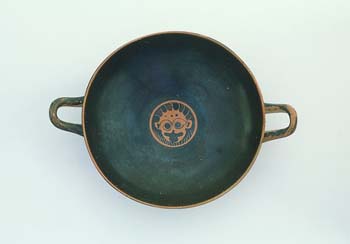Attic Black-figure Kylix
- ca. 520-500 BCE
- Class of the Top-Band Stemlesses (Greek) [D. Caccioli]
- Ceramic
7.8 x 23.8 x 17.3 cm., 3-1/8 x 9-3/8 x 6-7/8"
- Catherine Carter Goebel, Paul A. Anderson Chair in the Arts Purchase, Paul A. Anderson Art History Collection, Augustana College, 2000.54

Essay by Mark Leveling, Class of 2010
The field of art is constantly changing. New styles, ideas and techniques are always being conceptualized and utilized to give birth
to innovations in the art world. Artists often look to the past to fuel their creativity and produce new creations based on old concepts.
This idea is easily seen in the work of Pablo Picasso. His ceramic pitcher, Yan Face, looks as if he borrowed techniques from pottery
artists of the early Greek period. By examining the Greek Kylix and Picasso's Yan Face, it is possible to draw parallels between the
modern work of Picasso and the ancient works of the Greeks.
The design of the Kylix had the consumer of wine in mind. The outside of this particular Kylix has what appears to be a pair of eyes
and a lion in the middle of them. As the user finished his drink, he would find a Gorgon's head at the bottom of his chalice. The Gorgons
were said to be a group of sinister sisters who had snakes in place of hair and had the power to turn men to stone with their gaze.
Picasso used red clay full of earth tones and a black overtone very similar in composition to the ancient Greek Kylix. The red earthy
body is complemented with a black face and bird's head that appear to be painted over the clay. Picasso adapted the design of the clay
pitcher to advantage when he pinched the top for the bird's head. Yan Face is a classic example of borrowing from old art traditions and
applying them to modern concepts. This work is simple, yet it shows the diversity and innovation of Picasso.
It may be said that both the artist of the Kylix and Picasso used the same medium to construct their creations. Both works have the
similar composition of terracotta clay with black accents. Each has the potential to hold liquid. Another similarity between the works
is the presence of faces and eyes on the body of both vessels, each of which appears to be looking at the patron as if he were engaging
in some kind of contact. The media and composition resemble each other closely, but their uses are different. The Kylix had a known
function but although the ancient Greek Kylix may have given birth to the idea and medium for Picasso's Yan Face, Picasso clearly did not
intend for the valuable pitcher to be used in a practical manner, not to mention a wild drinking symposium.
